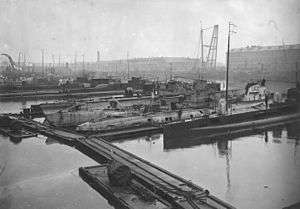Clorinde-class submarine
The Clorinde-class submarines were built for the French Navy prior to World War I. There were two boats in this class, neither of them would be used during World War I, but they operated in the Atlantic Ocean and the English Channel until they were stricken in 1926.
 Cornélie (far fight) and Clorinde (far left) at Cherbourg, 1920 | |
| Class overview | |
|---|---|
| Name: | Clorinde |
| Builders: | Arsenal de Rochefort |
| Operators: |
|
| Preceded by: | Charles Brun |
| Succeeded by: | Gustave Zédé class |
| Built: | 1910–17 |
| In service: | 1916–26 |
| In commission: | 1916–26 |
| Completed: | 2 |
| Scrapped: | 2 |
| General characteristics (as built) | |
| Type: | Submarine |
| Displacement: |
|
| Length: | 53.95 m (177 ft 0 in) (o/a) |
| Beam: | 5.1 m (16 ft 9 in) (deep) |
| Draft: | 3.45 m (11 ft 4 in) |
| Installed power: |
|
| Propulsion: | 2 shafts; 2 diesels; 2 electric motors |
| Speed: |
|
| Range: |
|
| Test depth: | 40 m (131 ft 3 in) |
| Complement: | 27 crew |
| Armament: |
|
Construction
The Clorinde-class submarines were both built at Arsenal de Rochefort in November 1910, they were double-hulled submarines and built under the 1909 programme Project of Julien Hutter on the basis of Labeuf Brumaire. They were launched in 1913 and the first submarine Clorinde was completed in October 1916, while her sistership Cornélie was finished in September 1917.[1]
When they were completed, the submarine was 53.9 metres (176 ft 10 in) long, with a beam of 5.1 metres (16 ft 9 in) and a draft of 3.4 metres (11 ft 2 in). The submarine was assessed at 567 GRT. They had 2 MAN-Loire diesels / 2 NANCY-electric motors which were powered by diesel oil and the engine was rated at 800 nhp. Her max. depth was 40 metres (131 ft 3 in), they could hold 29 crew and they were armed with 2 450 mm (17.7 in) bow torpedo tubes, 6 single 450 mm Drzewiecki drop collars of which 4 were placed at the aft of the submarine. They each also held a single 47 mm (1.9 in) deck gun which was installed in 1916 when they entered service.
Ships
| Name[2] | Launched[2] | Completed | Fate |
|---|---|---|---|
| Clorinde (Q90) | 2 October 1913 | 17 September 1917 | stricken, 15 January 1926 |
| Cornélie (Q91) | 29 October 1913 | 18 August 1916 | stricken, 20 December 1926 |
Notes
- Fontenoy, Paul E. (2007). Submarines: An Illustrated History of Their Impact. ISBN 9781851095636. Retrieved 29 December 2015.
- "French Submarines". worldnavalships.com. Retrieved 29 December 2015.
Bibliography
- Couhat, Jean Labayle (1974). French Warships of World War I. London: Ian Allan. ISBN 978-0-7110-0445-0.
- Gardiner, Robert & Gray, Randal (1985). Conway's All The World's Fighting Ships 1906–1921. London: Conway Maritime Press. ISBN 978-0-85177-245-5.
- Garier, Gérard (2002). A l'épreuve de la Grande Guerre. L'odyssée technique et humaine du sous-marin en France (in French). 3–2. Bourg-en-Bresse, France: Marines édition. ISBN 978-2-909675-81-7.
- Garier, Gérard (2000). Des Clorinde (1912-1916) aux Diane (1912–1917). L'odyssée technique et humaine du sous-marin en France (in French). 3–1. Bourg-en-Bresse, France: Marines édition. ISBN 978-2-909675-54-1.
- Roche, Jean-Michel (2005). "Classement par types". Dictionnaire des bâtiments de la flotte de guerre française de Colbert à nos jours 2, 1870 - 2006. Toulon: Roche. ISBN 978-2-9525917-0-6. OCLC 165892922.